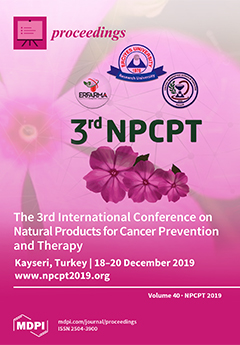Need Help?
Proceedings, 2019, NPCPT 2019
The 3rd International conference on Natural Products for Cancer Prevention and Therapy
Kayseri, Turkey | 18–20 December 2019
Volume Editor: Mukerrem Betul Yerer Aycan, Erciyes University, Turkey
- Issues are regarded as officially published after their release is announced to the table of contents alert mailing list.
- You may sign up for e-mail alerts to receive table of contents of newly released issues.
- PDF is the official format for papers published in both, html and pdf forms. To view the papers in pdf format, click on the "PDF Full-text" link, and use the free Adobe Reader to open them.
Cover Story (view full-size image):
Scientific experts from different countries and cities gathered to share their views and experience on the latest research on natural products being used for cancer prevention and therapy. The
[...] Read more.
Scientific experts from different countries and cities gathered to share their views and experience on the latest research on natural products being used for cancer prevention and therapy. The medicinal plant extracts, fractions and phytochemicals used for cancer prevention and therapy were discussed throughout the meeting. The scientific program comprised 11 plenary lectures, 17 oral presentations, and 24 posters, providing an opportunity for more than 60 scientists from different disciplines relating to cancer research to present their research over three days. The participants were able to network and engage in discussion regarding potential collaborations to advance their knowledge on the utility of natural products for the prevention and treatment of cancer.
Previous Issue
Next Issue
Issue View Metrics
Multiple requests from the same IP address are counted as one view.



